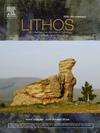Testing in-situ UPb garnet geochronology on a polymetamorphic schist from the Grenvillian basement of the Western Sierras Pampeanas, Argentina
IF 2.9
2区 地球科学
Q2 GEOCHEMISTRY & GEOPHYSICS
引用次数: 0
Abstract
Garnet, a common mineral in metamorphic rocks, frequently records complex textural and chemical zoning resulting from polymetamorphism. Dating metamorphic events using conventional methods (e.g., U![]() Pb zircon or Lu
Pb zircon or Lu![]() Hf garnet) is challenging and often fails to yield an accurate reconstruction of the P-T-t history in complex metamorphic regions. Recently, a technique has been developed for in situ U
Hf garnet) is challenging and often fails to yield an accurate reconstruction of the P-T-t history in complex metamorphic regions. Recently, a technique has been developed for in situ U![]() Pb LA-ICP-MS dating in garnets with very low concentrations of U and Pb. In this work we tested the method on polymetamorphic garnet from a sample of garnet-biotite schist from the Sierra de Maz (Western Sierras Pampeanas, Argentina). This rock belongs to a Grenvillian-age tectonic unit (nappe) that was reworked by the Famatinian orogeny (Ordovician-Silurian). The garnet porphyroblasts show a complex internal arrangement with three textural and compositional zones: Grt1 (cores), Grt2 (replacements) and Grt3 (overgrowths). Dating of a single porphyroblast yielded ages of 1045 ± 31 Ma for Grt1 and 476 ± 18 Ma for Grt2, confirming polymetamorphism resulting from the two main tectono-metamorphic events recorded in the Western Sierras Pampeanas. The garnet core (Grt1) age is within error of a 1037 ± 7 Ma zircon-rim U
Pb LA-ICP-MS dating in garnets with very low concentrations of U and Pb. In this work we tested the method on polymetamorphic garnet from a sample of garnet-biotite schist from the Sierra de Maz (Western Sierras Pampeanas, Argentina). This rock belongs to a Grenvillian-age tectonic unit (nappe) that was reworked by the Famatinian orogeny (Ordovician-Silurian). The garnet porphyroblasts show a complex internal arrangement with three textural and compositional zones: Grt1 (cores), Grt2 (replacements) and Grt3 (overgrowths). Dating of a single porphyroblast yielded ages of 1045 ± 31 Ma for Grt1 and 476 ± 18 Ma for Grt2, confirming polymetamorphism resulting from the two main tectono-metamorphic events recorded in the Western Sierras Pampeanas. The garnet core (Grt1) age is within error of a 1037 ± 7 Ma zircon-rim U![]() Pb age from the same rock. However, garnet (Grt2) is slightly older than ages recorded by different methods from the same tectonic unit (nappe), that are mostly in the range ca. 440–410 Ma including a CHIME monazite age of 426 ± 15 Ma from the same schist This discrepancy remains open to question, as Ordovician ages of metamorphism of ca. 470 Ma are common elsewhere in the Sierras Pampeanas.
Pb age from the same rock. However, garnet (Grt2) is slightly older than ages recorded by different methods from the same tectonic unit (nappe), that are mostly in the range ca. 440–410 Ma including a CHIME monazite age of 426 ± 15 Ma from the same schist This discrepancy remains open to question, as Ordovician ages of metamorphism of ca. 470 Ma are common elsewhere in the Sierras Pampeanas.
在阿根廷西塞拉-帕米亚纳斯山脉格伦维利亚基底的多变质片岩上测试UPb石榴石地质年代学
石榴石是变质岩中常见的矿物,经常记录多变质作用产生的复杂纹理和化学分带。使用传统方法(如 UPb 锆石或 LuHf 石榴石)确定变质事件的年代具有挑战性,往往无法准确重建复杂变质区域的 P-T-t 历史。最近,开发了一种对铀和铅浓度极低的石榴石进行原位 UPb LA-ICP-MS 测定的技术。在这项工作中,我们对来自 Sierra de Maz(阿根廷西Sierras Pampeanas)的石榴石-生物岩片岩样本中的多变质石榴石进行了测试。该岩石属于格勒维利时代的构造单元(岩层),后经法马提造山运动(奥陶纪-志留纪)再加工。石榴石斑岩内部排列复杂,有三个纹理和成分区:Grt1(核心)、Grt2(替代)和Grt3(过度生长)。对单个斑岩的年代测定结果表明,Grt1 的年代为 1045 ± 31 Ma,Grt2 的年代为 476 ± 18 Ma,这证实了在帕潘潘纳斯山脉西部记录的两个主要构造-变质事件所产生的多变质作用。石榴石岩芯(Grt1)的年龄与来自同一岩石的锆石-圈层 UPb 年龄(1037 ± 7 Ma)误差不大。不过,石榴石(Grt2)的年龄比同一构造单元(岩层)中用不同方法记录的年龄稍早,这些方法记录的年龄大多在约 440-410 Ma 之间,其中包括 CHAPE 年龄测定法。这一差异仍有待商榷,因为在帕潘潘纳山脉的其他地方,奥陶纪变质年龄约为 470Ma。
本文章由计算机程序翻译,如有差异,请以英文原文为准。
求助全文
约1分钟内获得全文
求助全文
来源期刊

Lithos
地学-地球化学与地球物理
CiteScore
6.80
自引率
11.40%
发文量
286
审稿时长
3.5 months
期刊介绍:
Lithos publishes original research papers on the petrology, geochemistry and petrogenesis of igneous and metamorphic rocks. Papers on mineralogy/mineral physics related to petrology and petrogenetic problems are also welcomed.
 求助内容:
求助内容: 应助结果提醒方式:
应助结果提醒方式:


